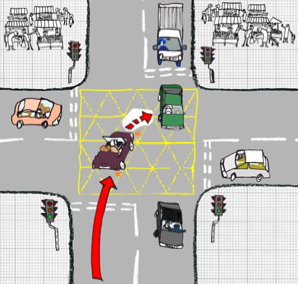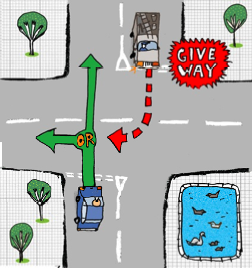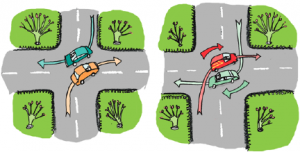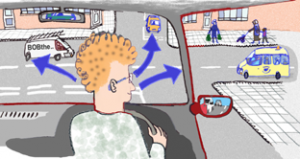
Manual vs. Automatic Driving Lessons: Which One Should You Choose?
Quick Answer: The key difference between manual and automatic driving lessons lies in the type
How To Master Crossroads
You could easily miss a crossroads. Whichever direction you approach from, your road appears to carry straight on. So you have to look out for road signs and for markings running across or to the side of the road ahead, as well as for other tell-tale signs such as a break in the line of buildings or parked cars.
The markings tell you if you are on the major or minor road and who has priority.
Road markings
Look out for the stop and give way road markings;

A black cross within a red triangle – one line of the cross is bolder than the other;

The two types of crossroads are known as controlled and uncontrolled.
At a controlled crossroads, one road has priority over the other. The controls take the form of road markings (give way and stop lines), traffic lights, and yellow boxes.
The traffic lights and road markings show who has priority. [Note that the only time you can wait in a yellow box control is when you want to turn right into a clear road, but you are prevented from driving on by a stream of oncoming traffic. If your exit road is not clear, you cannot enter the box.
At an uncontrolled crossroads, no one has priority. Imagine what a crossroads is like when the traffic lights fail. That’s one example of an uncontrolled crossroads.
Some crossroads are permanently uncontrolled. There are no traffic lights and no road markings. You should be ultra careful at an uncontrolled crossing.



Approaching from the minor road
You need to adapt the rules you learned about emerging from a minor road at a T junction. Instead of just checking to right and left in the sequence right-left-right, you should cover the road ahead.
This gives you a new sequence of checks: right-ahead-left-ahead-right. This simple sequence is the minimum you should do. As always, treat the junction with caution, and only emerge when it is safe to do so.
Approaching from the major road
Although you have priority, you must still look out for drivers coming from side roads. As you approach the crossroads, check your mirrors, ease your foot off the accelerator, and glance into the side roads to left and right. Do not miss out this procedure.
If you follow it every time, you should be able to react safely to anything unexpected.

Wimbledon Driving School
The Long Lodge
265 – 269 Kingston Road
Wimbledon,
London, SW19 3NW
Phone: 0800 511 8800

Quick Answer: The key difference between manual and automatic driving lessons lies in the type
Quick Answer If you’re an overseas driver in the UK, you can drive with a

If you’ve recently passed your driving test and want to build on your knowledge and